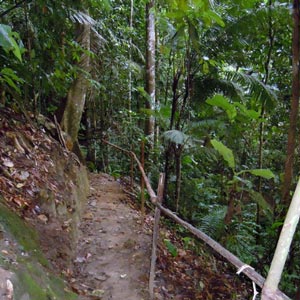Magazine | Études
Actualités ornithologiques colombiennes d’août 2009

Sentier dans la réserve El paujil (Colombie).Source : galerie Flickr de Proaves
Introduction
La Colombie est le pays qui compte le plus grand nombre d’espèces oiseaux dans le monde (1870) : toutefois, du fait de nombreuses menaces (développement agricole, exploitation forestière, chasse, culture illégale de la coca…), plusieurs d’entre elles sont désormais en danger.
Au centre du pays, le bassin du Rio Magdalena était autrefois couvert d’une vaste forêt riche en endémiques. Mais il n’en reste plus que des lambeaux, comme la réserve naturelle El Paujil : ProAves (www.proaves.org) et ses associés essaient d’acquérir des propriétés voisines et vous pouvez l’y aider (Ornithomedia y a contribué).
La réserve naturelle El Paujil protège l’un des derniers bastions du Hocco d’Albert, et grâce à la protection de la zone, les observations de cette espèce en danger critique se sont récemment multipliées.
Il reste dans le pays des joyaux naturels encore méconnus et miraculeusement épargnés, comme la Serranía de San Lucas, un petit massif encore largement boisé au nord du pays. Mais le gouvernement colombien vient d’accorder à plusieurs compagnies des concessions minières qui risquent d’anéantir sa richesse naturelle.
Abstract
ProAves (www.proaves.org) is a non profit Colombian organization born in 1998 to start bird conservation in Colombia. Today, it leads bird conservation efforts in Colombia through a multi-faceted approach of good science, strong community relations and protection of the most important sites and landscapes for birds.
Here are several news published in August 2009 on its website:
ProAves has acquired strategic private properties from loggers and coca farmers to double the protection of the Paujil Nature Reserve to 6,935 acres thanks to the support of ABC and WLT-US. The El Paujil Nature reserve represents the most important rainforest protected area in the Magdalena valley of Colombia.
Recent observations of startling and up to three males and the first photos of two females and one male Blue-billed Curassow (Crax alberti), one of the most endangered birds in South America, shows the effective protection and the importance of the El Paujil Reserve for the survival of this charismatic Colombian endemic.
The Serranía de San Lucas is one of the last frontiers unknown to science, isolated and once covered with 2.5 million acres of forest to over 7,500 feet elevation. Only a fraction of its forests survive, and almost all has been designated to mining concessions. This incredible and unique massif is at imminent risk of extinction.
Poursuivez la lecture de cet article, en vous abonnant dès maintenant !
Découvrez les Archives d’Ornithomedia.com
Pour seulement 10,00 €TTC/an (ou 6,00 € les 6 mois)
Profitez de plusieurs centaines d’articles en accès illimité et sans aucun engagement.
Compléments
À lire aussi sur Ornithomedia.com
- Première photo du Campyloptère des Santa Marta
- Observer les oiseaux sur le « front pionnier » colombien : le secteur de San José del Guaviar
À lire sur el web
La galerie de Proaves sur Flickr : www.flickr.com/photos/proaves
Ouvrages recommandés
- Field Guide to the Birds of Colombia de Miles McMullan, Thomas M Donegan et Alonso Quevedo
- The Birds of Costa Rica: A Field Guide de Richard Garrigues (Auteur), Robert Dean (Illustrations)
- Birds of Costa Rica de Richard Garrigues
- Birds of Costa Rica: A Field Guide de Carrol L. Henderson, Alexander F. Skutch et Steve Adams
Source
Salaman P. G. W. & Donegan T. M. (eds.) (2001) Presenting the first biological assessment of Serranía de San Lucas. Colombian EBA Project Report Series No. 3. Publié en ligne par la Fundación ProAves, Colombia at www.proaves.org. 36 pp. ISSN 1811-1246. www.proaves.org/IMG/pdf/EBA_3_San_Lucas_report_2001-2.pdf




Aucun commentaire sur ce sujet
Participer à la discussion !